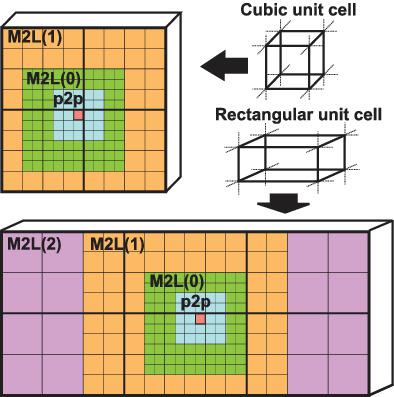当前位置:
X-MOL 学术
›
J. Comput. Chem.
›
论文详情
Our official English website, www.x-mol.net, welcomes your feedback! (Note: you will need to create a separate account there.)
Extension of the fast multipole method for the rectangular cells with an anisotropic partition tree structure
Journal of Computational Chemistry ( IF 3 ) Pub Date : 2020-02-26 , DOI: 10.1002/jcc.26180 Yoshimichi Andoh 1 , Noriyuki Yoshii 1 , Susumu Okazaki 2
Journal of Computational Chemistry ( IF 3 ) Pub Date : 2020-02-26 , DOI: 10.1002/jcc.26180 Yoshimichi Andoh 1 , Noriyuki Yoshii 1 , Susumu Okazaki 2
Affiliation

|
The fast multipole method (FMM) is an order N method for the numerically rigorous calculation of the electrostatic interactions among point charges in a system of interest. The FMM is utilized for massively parallelized software for molecular dynamics (MD) calculations. However, an inconvenient limitation is imposed on the implementation of the FMM: In three‐dimensional case, a cubic MD unit cell is hierarchically divided by the octree partitioning under isotropic periodic boundary conditions along three axes. Here, we extended the FMM algorithm adaptive to a rectangular MD unit cell with different periodicity along the axes by applying an anisotropic hierarchical partitioning. The algorithm was implemented into the parallelized general‐purpose MD calculation software designed for a system with uniform distribution of point charges in the unit cell. The partition tree can be a mixture of binary and ternary branches, the branches being chosen arbitrarily with respect to the coordinate axes at any levels. Errors in the calculated electrostatic interactions are discussed in detail for a selected partition tree structure. The extension enables us to execute MD calculations under more general conditions for the shape of the unit cell, partition tree, and boundary conditions, keeping the accuracy of the calculated electrostatic interactions as high as that with the conventional FMM. An extension of the present FMM algorithm to other prime number branches, such as 5 and 7, is straightforward.
中文翻译:

具有各向异性划分树结构的矩形单元的快速多极方法的扩展
快速多极法 (FMM) 是一种 N 阶方法,用于对感兴趣系统中的点电荷之间的静电相互作用进行严格的数值计算。FMM 用于分子动力学 (MD) 计算的大规模并行软件。然而,对 FMM 的实现施加了一个不方便的限制:在三维情况下,立方 MD 晶胞在沿三个轴的各向同性周期性边界条件下通过八叉树分区分层划分。在这里,我们通过应用各向异性分层划分将 FMM 算法扩展为适应沿轴具有不同周期性的矩形 MD 单位单元。该算法被实施到并行化的通用 MD 计算软件中,该软件专为具有单位单元中点电荷均匀分布的系统而设计。分区树可以是二元和三元分支的混合,可以相对于任何级别的坐标轴任意选择分支。对于选定的分区树结构,详细讨论了计算出的静电相互作用中的误差。该扩展使我们能够在更一般的晶胞形状、分区树和边界条件的条件下执行 MD 计算,保持计算的静电相互作用的精度与传统 FMM 一样高。将当前 FMM 算法扩展到其他素数分支,例如 5 和 7,是直接的。分区树可以是二元和三元分支的混合,可以相对于任何级别的坐标轴任意选择分支。对于选定的分区树结构,详细讨论了计算出的静电相互作用中的误差。该扩展使我们能够在更一般的晶胞形状、分区树和边界条件的条件下执行 MD 计算,保持计算的静电相互作用的精度与传统 FMM 一样高。将当前 FMM 算法扩展到其他素数分支,例如 5 和 7,是直接的。分区树可以是二元和三元分支的混合,可以相对于任何级别的坐标轴任意选择分支。对于选定的分区树结构,详细讨论了计算出的静电相互作用中的误差。该扩展使我们能够在更一般的晶胞形状、分区树和边界条件的条件下执行 MD 计算,保持计算的静电相互作用的精度与传统 FMM 一样高。将当前 FMM 算法扩展到其他素数分支,例如 5 和 7,是直接的。对于选定的分区树结构,详细讨论了计算出的静电相互作用中的误差。该扩展使我们能够在更一般的晶胞形状、分区树和边界条件的条件下执行 MD 计算,保持计算的静电相互作用的精度与传统 FMM 一样高。将当前 FMM 算法扩展到其他素数分支,例如 5 和 7,是直接的。对于选定的分区树结构,详细讨论了计算出的静电相互作用中的误差。该扩展使我们能够在更一般的晶胞形状、分区树和边界条件的条件下执行 MD 计算,保持计算的静电相互作用的精度与传统 FMM 一样高。将当前 FMM 算法扩展到其他素数分支,例如 5 和 7,是直接的。
更新日期:2020-02-26
中文翻译:

具有各向异性划分树结构的矩形单元的快速多极方法的扩展
快速多极法 (FMM) 是一种 N 阶方法,用于对感兴趣系统中的点电荷之间的静电相互作用进行严格的数值计算。FMM 用于分子动力学 (MD) 计算的大规模并行软件。然而,对 FMM 的实现施加了一个不方便的限制:在三维情况下,立方 MD 晶胞在沿三个轴的各向同性周期性边界条件下通过八叉树分区分层划分。在这里,我们通过应用各向异性分层划分将 FMM 算法扩展为适应沿轴具有不同周期性的矩形 MD 单位单元。该算法被实施到并行化的通用 MD 计算软件中,该软件专为具有单位单元中点电荷均匀分布的系统而设计。分区树可以是二元和三元分支的混合,可以相对于任何级别的坐标轴任意选择分支。对于选定的分区树结构,详细讨论了计算出的静电相互作用中的误差。该扩展使我们能够在更一般的晶胞形状、分区树和边界条件的条件下执行 MD 计算,保持计算的静电相互作用的精度与传统 FMM 一样高。将当前 FMM 算法扩展到其他素数分支,例如 5 和 7,是直接的。分区树可以是二元和三元分支的混合,可以相对于任何级别的坐标轴任意选择分支。对于选定的分区树结构,详细讨论了计算出的静电相互作用中的误差。该扩展使我们能够在更一般的晶胞形状、分区树和边界条件的条件下执行 MD 计算,保持计算的静电相互作用的精度与传统 FMM 一样高。将当前 FMM 算法扩展到其他素数分支,例如 5 和 7,是直接的。分区树可以是二元和三元分支的混合,可以相对于任何级别的坐标轴任意选择分支。对于选定的分区树结构,详细讨论了计算出的静电相互作用中的误差。该扩展使我们能够在更一般的晶胞形状、分区树和边界条件的条件下执行 MD 计算,保持计算的静电相互作用的精度与传统 FMM 一样高。将当前 FMM 算法扩展到其他素数分支,例如 5 和 7,是直接的。对于选定的分区树结构,详细讨论了计算出的静电相互作用中的误差。该扩展使我们能够在更一般的晶胞形状、分区树和边界条件的条件下执行 MD 计算,保持计算的静电相互作用的精度与传统 FMM 一样高。将当前 FMM 算法扩展到其他素数分支,例如 5 和 7,是直接的。对于选定的分区树结构,详细讨论了计算出的静电相互作用中的误差。该扩展使我们能够在更一般的晶胞形状、分区树和边界条件的条件下执行 MD 计算,保持计算的静电相互作用的精度与传统 FMM 一样高。将当前 FMM 算法扩展到其他素数分支,例如 5 和 7,是直接的。


























 京公网安备 11010802027423号
京公网安备 11010802027423号